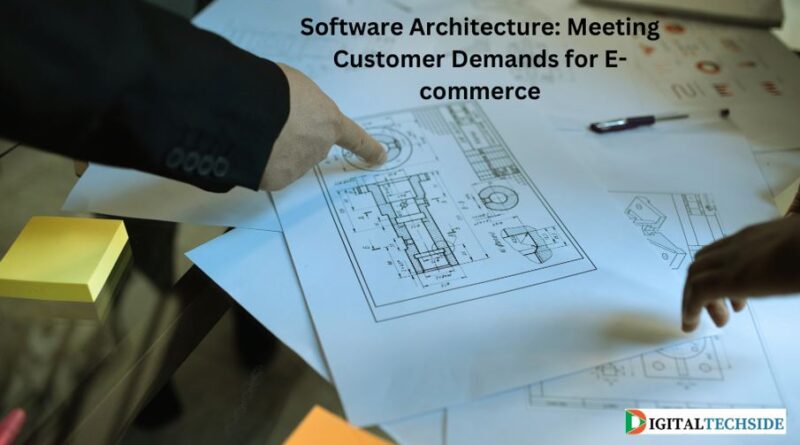Software Architecture: Meeting Customer Demands for E-commerce
Introduction
In the fast-changing realm of e-commerce, companies are always trying to adapt to the needs of their clients. E-commerce businesses need a strong and adaptable software architecture, together with a dynamic and flexible strategy, to thrive in this competitive climate. For every online firm to succeed, satisfying consumer demands for e-commerce through efficient software architecture is key. The architecture of e-commerce software is crucial to delivering a smooth along with fulfilling client experience.
Demystifying Software Architecture: The Foundation of E-commerce Excellence
Software architecture forms the very essence of an e-commerce platform, defining the intricate interplay between its various components. It establishes the cohesive functioning of the system, guaranteeing scalability, dependability, and security—these three are the main components of successful e-commerce.
The Significance of Software Architecture in E-commerce
A well-conceived software architecture yields a multitude of benefits, empowering e-commerce businesses to navigate the digital landscape with agility and resilience.
Enhanced Performance
A scalable architecture seamlessly handles spikes in traffic, ensuring the platform remains responsive and efficient even during peak periods.
Unmatched Flexibility
A modular architecture empowers businesses to effortlessly incorporate new features and functionalities without disrupting the existing system.
Cost-Effective Maintenance
A well-documented architecture simplifies bug identification and resolution, minimizing maintenance costs and maximizing uptime.
Impregnable Security
A secure architecture shields sensitive customer data from unauthorized access and cyberattacks, safeguarding both customer trust and business reputation.
Aligning Software Architecture with Customer Demands: The Evolving Landscape
To meet the expectations of today’s discerning e-commerce customers, businesses must prioritize the following factors when designing their software architecture:
Omnichannel Experience
Customers demand a seamless and consistent experience across multiple channels, including websites, mobile apps, and social media platforms. The software architecture must seamlessly integrate these channels to deliver a unified customer journey.
Personalized Engagement
Customers crave personalized recommendations and offers tailored to their preferences and past interactions. The software architecture should facilitate data collection and analysis to enable effective personalization strategies.
Real-time Updates
Customers expect instant access to accurate information, including product availability, pricing, and delivery status. The Software design must support real-time data updates to ensure customers receive the most up-to-date information.
Popular Software Architecture Patterns for E-commerce: Paving the Way for Success
Several software architecture patterns have emerged as frontrunners in the e-commerce domain:
Microservices Architecture
This pattern deconstructs the platform into smaller, independent services, each responsible for a specific function. This approach fosters scalability, ease of deployment, and simplified maintenance.
API-Driven Architecture
APIs act as bridges between different components of the platform, facilitating seamless communication. This pattern enables integration with third-party services and expedites the development of new features.
Cloud-based Architecture
Cloud-based architectures offer unparalleled scalability, elasticity, and cost-effectiveness. They also enable businesses to rapidly deploy new features and updates.
Conclusion
E-commerce companies may enable themselves to develop platforms that not only satisfy the needs of current consumers but also adjust to the constantly shifting digital environment by carefully designing their software architecture. E-commerce companies that have a strong and adaptable architecture at their foundation can successfully travel the road to success, building client loyalty, increasing revenue, and securing their position in the rapidly changing e-commerce market.
FAQs
Q: What distinguishes a monolithic architecture from a microservices architecture?
Ans: A monolithic architecture is a single, self-contained application, whereas a microservices architecture comprises independent services that communicate via APIs.
Q: What benefits do APIs offer in the context of e-commerce architecture?
Ans: APIs facilitate effortless integration with third-party services, such as payment gateways and shipping providers. They also streamline the development of new features and functionalities.
Q: What challenges arise when implementing a cloud-based e-commerce architecture?
Ans: Ensuring the security of sensitive customer data and managing cloud service costs are two primary challenges.
Q: How can businesses select the most suitable software design for their e-commerce needs?
Ans: Businesses should carefully consider their specific requirements, including customer base size, product catalog complexity, and budget. Consulting experienced software architects is also highly recommended.

As a DIGITALTECHSIDE author, the majority of our articles have been focused on technology, blogging, business, lifestyle, social media, web design and development, e-commerce, money, health, education, entertainment, SEO, travel, and sports.
Contact us at digitaltechside@gmail.com if you have questions of anything.




